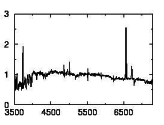
|

FAST Spectrograph
|

|
|
qfast is an IRAF CL script written by Doug Mink to find an object
near the center of a 2-D spectrum, extract it into a wavelength-calibrated
1-D spectrum, and compute a redshift.
It uses the IRAF tasks procdata.findspec from the SAO saotdc package;
apextract.apall from the NOAO twodspec package;
refspec, dispcor, and splot from the IRAF onespec package;
and xcsao and emsao from the SAO rvsao package.
The procdata package must be loaded in IRAF. The qfast parameter file should more or less look like this: nobs = 60 FAST image number to process (rootdir= /fast/flwo1/) Spectum image root directory (obsdate= 1999/03/13) Date of observation directory (yy/mm/dd) (fcal = 0000.comp) Calibration file name (caldir = /home/observer/qfast/) Calibration image directory (row1 = 2) First row for spectrum search (row2 = 80) Last row for spectrum search (keepnam= yes) Keep object name in file name (y or n) (apdisp = yes) Display aperture and background (y or n (imdisp = no) Display raw image (y or n) (spdisp = yes) Display spectrum (y or n) (quickre= no) Find redshift (y or n)? (delquic= no) Delete quick-look 1-D spectrum (y or n)? (verbose= no) Log progress (y or n)? (flpar = no) flush pfile on assign? (mode = ql)where obsdate should be changed to data directory date. fcal should be the COMP file used for the wavelength solution. The resultant .ms file should exist in the specified directory (caldir, note the last / sign). The id file (e.g., id0000.comp.ms should exist in the database subdirectory found in caldir. These files are normally kept in the /home/observer/qfast directory as listed above, and are archived in a files that restore.obs will retrieve in case you need to retrieve them. 0000.comp is useful for 300gpm work. For the 600gpm in blue, there is a file called 600gpm that can be used. In general, run qfast from the observer/qfast subdirectory, and not the data directory. "qfast 23" will extract the spectrum from the file 0023.* in the set data directory. |